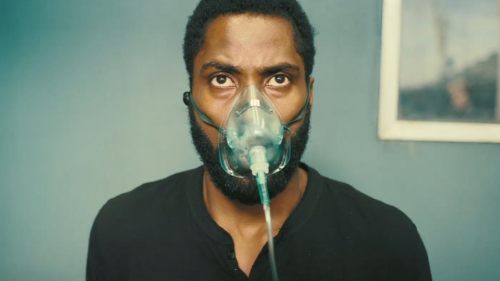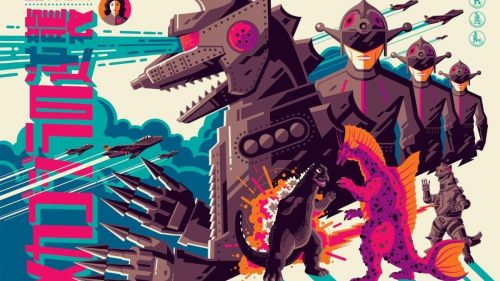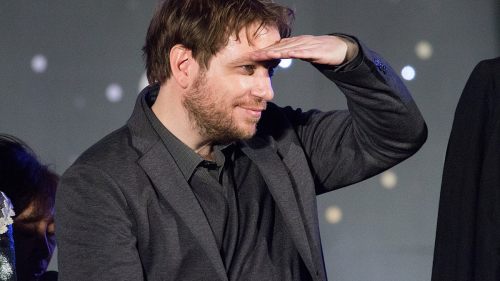GODZILLA (2014) Movie Review: Using CGI To Make Man-In-Suit
You get desensitized. It’s hard not to in the current blockbuster climate; anything is possible on screen, and anything that can be exploded will be exploded. Any creature can be brought to life, the strangest figment of any imagination can be given weight and texture and something approaching reality. There’s no longer a science fiction concept or comic book scene that’s ‘impossible’ to bring to the screen; in an ADD world where audiences have been weaned on the hyperactive incoherence of Michael Bay’s Transformers films how do you wow them anymore? What does a prehistoric atomic monster like Godzilla have to do to stand out?
Director Gareth Edwards has seen this problem and confronted it in a way that will delight those who revel in the feeling of awe, but will bore those who go to the movies to be beaten into submission by sound and fury. He has made a Godzilla movie that keeps the title character offscreen for much of the running time, revealing him largely in pieces - a thrashing tail, a stomping foot, a spiky back swimming inexorably across the Pacific. And when the King of the Monsters - crowned as such in this film! - does really make his full appearance Edwards gives us a sense of scale, an understanding of his size and, as such, a true feeling of awe.
And then he has Godzilla engage in classic man-in-suit action. Gareth Edwards spent millions upon millions of dollars to make highly sophisticated computers recreate the look and feel of classic Toho monster brawl action, and it is absolutely glorious.
The film’s burn may be a touch too slow upfront. The movie opens in 1999 (the year after Emmerich’s Godzilla, although that’s either a joke or an accident - this movie is not a sequel to any of the previous Godzilla movies) with the discovery of an ancient skeleton in the Philippines that is bigger than anything that has ever been known to live. Attached to the skeleton are egg sacs, most of which are fossilized. One, though, has hatched. The unseen thing that was in that sac heads across the Pacific towards a coastal Japanese nuclear reactor. It (still unseen) destroys the reactor, and with it the lives of the American engineer family who run it.
The film cuts ahead fifteen years; Bryan Cranston is Joe Brody, who lost his wife that day. He’s never returned home and has stayed in Japan trying to get to the bottom of the accident that ruined him. He knows it wasn’t a natural disaster, and he knows that the quarantine zone that has cut the city off from the world is a sham. His son, Ford (Aaron Taylor-Johnson) goes with him into the quarantine zone, where they discover a huge cocoon that is about to open, unleashing a giant monster onto the world.
And then Godzilla gets involved.
The film (with a script by Max Borenstein from a story by Dave Callaham) is staged as a series of reveals, going from the mystery of the collapsed nuclear plant to the full-on fury of Godzilla. In some ways this is great - imagine a camera pulling back from one detail on a painting, slowly revealing the majesty of a huge mural. But in the case of Godzilla that initial detail is a little boring, especially because we already know the basic shape of the rest of the mural. And since the film is (very effectively) utilitarian with its characters, a lot of this set-up is simply pointless. It adds atmosphere, and there’s a nice attitude of withholding that gives Godzilla’s first appearance a seismic impact.
But even after Godzilla is introduced - attacking the MUTO, the insectoid beast hatched from that cocoon - in Hawaii, Edwards keeps him hidden. The two have a massive battle that destroys Honolulu, but we only see clips of it on TV screens. Edwards wants you to wait for it. He wants to build the anticipation. This is a seduction, not a ravishing.
Edwards got this job on the strength of his film Monsters, and if you’ve seen that film you will know exactly what you’re in for with Godzilla. Edwards keeps his camera locked into subjective points of view, almost always showing us action from the POV of a human in the scene. This creates the scale that makes the whole film work; otherwise everything would feel untethered from reality and essentially weightless. It’s only at the end, in the huge final battle in San Francisco that Edwards unchains his camera from humanity and gives us the great objective view we’ve been dying to get.
It works. If Edwards had just given us the whole monster in its first appearance the rest of the film would have been a gradual deflation, an overexposure that would have ended up with a battle that felt samey and repetitive. By withholding he gives us truly spine-tingling moments of visual grandness; will I see a cooler shot this year than the one of an enormous Godzilla swimming in the Pacific, flanked by diminutive destroyers and battleships, all headed together to fight MUTO?
Yeah, about that: Godzilla’s the good guy. He’s come up from the depths to fight the newly awoken kaiju, and while he’s here to stop the bad monsters that doesn’t mean he’s stepping around buildings. Edwards makes this point very early on, as Godzilla coming ashore in Hawaii creates a tidal wave that kills hundreds of people. Godzilla is a force of nature, and he’s not really concerned with you or I. He’s just getting the job done.
Early marketing for Godzilla positioned it as grim, a dark meditation on the destruction that would be caused by such a gargantua run amok. That isn’t the film; it’s serious-minded, but not at the expense of fun. A young boy who is separated from his parents in an early attack finds himself returned to them, a stark contrast to images from the 1954 film, where we see a woman cradling her dead child in a hospital hallway. The destruction has weight, but not so much that it makes you feel bad for watching. And Godzilla’s advance towards the US is slow enough that much of San Francisco is safely evacuated before he gets there, allowing us to stomp our cake and eat it too.
The final battle is a masterpiece of kaiju action. I don’t know what the general audience will make of it, as it’s absolute classic monster wrestling. Some of the shots of the flying MUTO look like they were achieved with a guy on a wire, and it’s wonderful. Edwards understands the tone exactly, knows that we want wide angle shots of monsters hitting each other and grappling for dominance, not quick cuts and shaky confusion obscured by debris and smoke. When Godzilla charged up his atomic breath I actually burst into spontaneous applause. If you like these kinds of movies this scene will be worth the price of admission alone.
Edwards sprinkles other sorts of action along the way, including a scene that is clearly an homage to the raptors in the kitchen in Jurassic Park (which takes on a new impact when the raptor is a four hundred foot tall bug thing), but mostly he goes for impressive spectacle. It’s big shots of big events, intended to give you a sense of awe. That’s not what blockbusters do these days - we live in a world where constant, escalating action is the order of the day. This is a very old-fashioned movie.
While the monster stuff and the spectacle is absolutely astonishing and wonderful, the rest of the film is a touch flat. The story follows Ford as he tries to get from Japan to his family in San Francisco, his route matching the rampaging monsters. He’s military, and so he pitches in and helps along the way, getting himself on the front lines of the battle. Unfortunately Johnson is stiff, although he’s not given much to do except to get to the next scene. It’s not distractingly bad, but it’s skippable… which really places this film in the grand Godzilla tradition.
None of the human leads are that interesting, but Elizabeth Olsen is especially wasted. She’s kept back in San Francisco worrying about Johnson, who plays her husband, and has so little to do that I assume 60% of her scenes ended up on the cutting room floor. It’s a pity, because you can imagine what her story - she’s a nurse who ends up in a civil shelter as kaiju battle directly over her head - could have been like.
Nobody’s going to walk out of Godzilla wanting to buy toys of the human characters, but their story works as a functional narrative connecting all the pieces. The film mainly focuses on the military reaction anyway, a highly functional series of responses to the growing (and multiplying) kaiju threat. The reality is that Godzilla is all about the slow build towards the end, the continuing scenes of gorgeous monsters headed for titanic showdowns. Godzilla isn’t the holy grail blockbuster - it isn’t the perfect marriage of spectacle and humanity and intelligence - but it’s very much a huge budget American take on the Showa era of classic Gojira.



